The vast western vistas, the Panavision Hollywood backdrops, the rambling highways of adventure and the endless scenic horizons— all are emblematic settings of the American far west, and the wellspring for much of Ed Ruscha’s ouevre. Although he was born in Omaha, Nebraska, and grew up in Oklahoma, Ruscha adopted this landscape, and Los Angeles in particular, as both his home and the font of inspiration from which he began gathering and absorbing material in 1956 on his first road trip here at the age of 18. The revelatory journey in a Ford sedan took Route 66 along the way. In his subsequent work, Ruscha explored the gas stations by the the highway, the telephone poles, billboards, flat tires and trash, along with the palm tree-fringed skylines, the iconography of the film industry, the Hollywood sign and the romance of the Pacific coast. He re-contextualized—and continues to re-contextualize—such familiar and not-so-familiar landmarks, bringing them into a new focus, flavored with his characteristic wit.
de Young Museum – San Francisco
Ed Ruscha and The Great American West
(July 16 — October 9, 2016)
Long a Los Angeles icon himself, inextricably entrenched in the local culture that has embraced him back, it’s revealing to re-encounter the artist in this insightful retrospective at the de Young Museum. The Northern California venue offers a sort of contextual shift for engagement with Ruscha’s LA-centric work. Setting the stage for the retrospective is a selection of the artist’s stunning series focused on the Standard gas stations beginning in the 1960s. The word Standard is tinged with a hint of double entendre: There is nothing standard about Ruscha’s envisioning of it. The vantage point of the original composition is still surprising, as if viewed from below, looking up at the red gas pumps in a row and the rectangular forms of the station and roof, which appear in an unexpectedly skewed perspective. Ruscha repeated the same composition with myriad variations—incorporating flames in the sky, for instance, or replacing the blue sky of daylight with the black background of night. He revisited the composition, decades later, with, Ghost Station (2011, mixografia print on handmade paper) in which the image is only seen in relief on white, like an embossing, reducing the idea to its simplest elements, melting into pure abstraction.
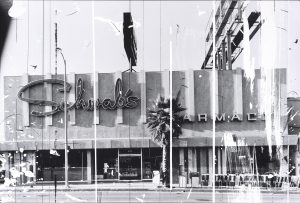 Ed Ruscha. Schwab’s Pharmacy, 1976; 1976, from The Sunset Strip, series published in 1995; Gelatin silver print from altered negative; 20 x 30 (50.8 x 76.2 cm). Published by Patrick Painter Editions, Vancouver and Hong Kong. Fine Arts Museums of San Francisco, Museum purchase, Mrs. Paul L. Watts Fund.
Ed Ruscha. Schwab’s Pharmacy, 1976; 1976, from The Sunset Strip, series published in 1995; Gelatin silver print from altered negative; 20 x 30 (50.8 x 76.2 cm). Published by Patrick Painter Editions, Vancouver and Hong Kong. Fine Arts Museums of San Francisco, Museum purchase, Mrs. Paul L. Watts Fund.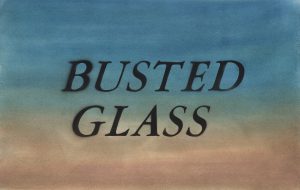 Ed Ruscha. Busted Glass, 2014; Dry pigment and acrylic on paper; 15 x 22 3/8 (38.1 x 56.8 cm); Fine Arts Museums of San Francisco, Museum purchase, Achenbach Foundation for Graphic Arts Endowment Fund and gift of the Achenbach Graphic Arts Council.
Ed Ruscha. Busted Glass, 2014; Dry pigment and acrylic on paper; 15 x 22 3/8 (38.1 x 56.8 cm); Fine Arts Museums of San Francisco, Museum purchase, Achenbach Foundation for Graphic Arts Endowment Fund and gift of the Achenbach Graphic Arts Council.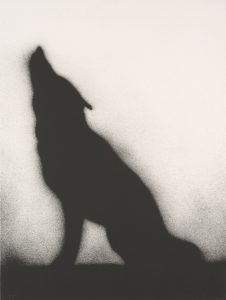 Ed Ruscha. Coyote, 1989; Lithograph; 36 x 27 (91.4 x 68.6 cm); Published by the artist. Fine Arts Museums of San Francisco, Museum purchase, Mrs. Paul L. Wattis Fund.
Ed Ruscha. Coyote, 1989; Lithograph; 36 x 27 (91.4 x 68.6 cm); Published by the artist. Fine Arts Museums of San Francisco, Museum purchase, Mrs. Paul L. Wattis Fund.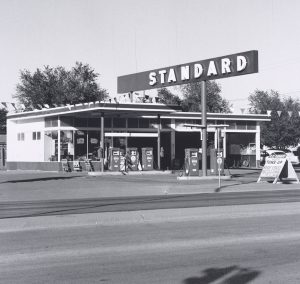 Ed Ruscha. Standard Station, Amarillo, Texas, 1962 Gelatin silver print. 4 15/16 x 5 1/16 (12.5 x 12.9 cm) Whitney Museum of American Art, New York, Purchase with funds from The Leonard and Evelyn Lauder Foundation, and Diane and Thomas Tuft
Ed Ruscha. Standard Station, Amarillo, Texas, 1962 Gelatin silver print. 4 15/16 x 5 1/16 (12.5 x 12.9 cm) Whitney Museum of American Art, New York, Purchase with funds from The Leonard and Evelyn Lauder Foundation, and Diane and Thomas Tuft Ed Ruscha. Gas, 1962; Lithograph; 20 x 15 (50.8 x 38.1 cm); Published by the artist. Fine Arts Museums of San Francisco, Museum purchase, Mrs. Paul L. Wattis Fund.
Ed Ruscha. Gas, 1962; Lithograph; 20 x 15 (50.8 x 38.1 cm); Published by the artist. Fine Arts Museums of San Francisco, Museum purchase, Mrs. Paul L. Wattis Fund. Ed Ruscha. Noose Around Your Neck, from the series Country Cityscapes, 2001; Color photogravure with screenprint 18 x 14 (45.7 x 35.6 cm); Published by Graphicstudio, University of Florida, Tampa. Fine Arts Museums of San San Francisco, Gift of the artist.
Ed Ruscha. Noose Around Your Neck, from the series Country Cityscapes, 2001; Color photogravure with screenprint 18 x 14 (45.7 x 35.6 cm); Published by Graphicstudio, University of Florida, Tampa. Fine Arts Museums of San San Francisco, Gift of the artist. Ed Ruscha. Rodeo, 1969; Color lithograph; 17 x 24 (43.2 x 61 cm); Published by Tamarind Lithography Workshop, Los Angeles. Fine Arts Museums of San Francisco, Museum purchase, Mrs. Paul L. Wattis Fund.
Ed Ruscha. Rodeo, 1969; Color lithograph; 17 x 24 (43.2 x 61 cm); Published by Tamarind Lithography Workshop, Los Angeles. Fine Arts Museums of San Francisco, Museum purchase, Mrs. Paul L. Wattis Fund.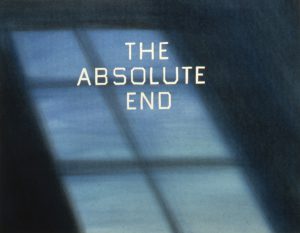 Ed Ruscha. The Absolute End, 1982. Dry pigment on paper 23 x 29 (58.4 x 73.7 cm) The Robert A. Rowan Collection
Ed Ruscha. The Absolute End, 1982. Dry pigment on paper 23 x 29 (58.4 x 73.7 cm) The Robert A. Rowan Collection
In the series, the use of text—the word ‘Standard’—was an organic element of the subject, a component of the original gas station captured in a photograph as a reference. Ruscha went on to superimpose sometimes incongruous text on many of his images, or used text as the sole subject, his pithy lines amplifying what might otherwise be regarded as dreary mundane things about life in the west—as in the 1977 pastel on paper work (expanded into a mural in 2014/2015): Honey, I Twisted Through More Damn Traffic Today.
As a kid, Ruscha was most interested in making cartoons. After attending Chouinard Art Institute from 1956 to 1960, he launched a career as a graphic artist in the advertising industry. The technical expertise acquired via that experience, along with the tools, the use of type, and the marriage of image to words, integrated into Ruscha’s visual lexicon, becoming a stepping-off point he went on to adapt, leverage and elevate to fine art.
His soft focus airbrush paintings and prints exploring symbols from film are a nostalgic homage to the cinema, as is his series playing on the words, The End, as they used to appear at the end of old movies.
As words and text became integral to Ruscha’s imagery, it was natural that he began producing artist’s books. Back home, at Gagosian Gallery in Beverly Hills, during the course of the de Young exhibit, Ed Ruscha: Prints & Photographs and Ed Ruscha: Books & Co. offered a timely complement to the museum retrospective. The book survey was mounted so viewers could handle and turn the pages of many of the books. The artist’s concept books consist of photographs of cultural curiosities—beginning with Twentysix Gasoline Stations, which Ruscha published in 1962 under his own imprint, and which gradually attained a kind of cult following. He went on to publish many more books, all offering a wry portrayal of phenomena mostly related to his road trips and life in Los Angeles, like Nine Swimming Pools and a Broken Glass (1968). The survey also included a vast collection of tribute books on related themes (Twentysix Abandoned Gas Stations, Twentysix African Gas Stations) by artists inspired by Ruscha.
In his paintings, prints, photographs and books, Ruscha has done much more than simply immortalize and distill symbols of the West. He recognized the deeper innuendo in ordinary everyday things—in many instances lifting them out of the quotidian visual vernacular and reframing them, prodding the viewer to see them in a new light. Bridging genres, Ruscha is a painter, photographer, printmaker, conceptual artist, visionary and, with his adroit use of words, poet. For more than half a century, he has offered a witty and perceptive commentary on American culture rooted in the West. In a timeless way, his work captures the essence of the excitement and newness he must have experienced as a teenager, arriving here on his first trip from Oklahoma.




